1. Learning in the flow of work
Learning in the flow of work has become inevitable in the corporate world. Due to business constraints, increased workload and limited human resource, it has become difficult to release employees to attend training. Hence Organizations are looking at innovative ways of instilling learning in the flow of work.
In the article written by Josh Bersin–
Learning in the Flow of Work is the entire domain of learning “as needed” through existing tools, platforms, or based on context. It includes the use of micro-learning in other platforms (ie. Salesforce, Teams, Slack).
Kindly find below the conventional Training Framework for instance –
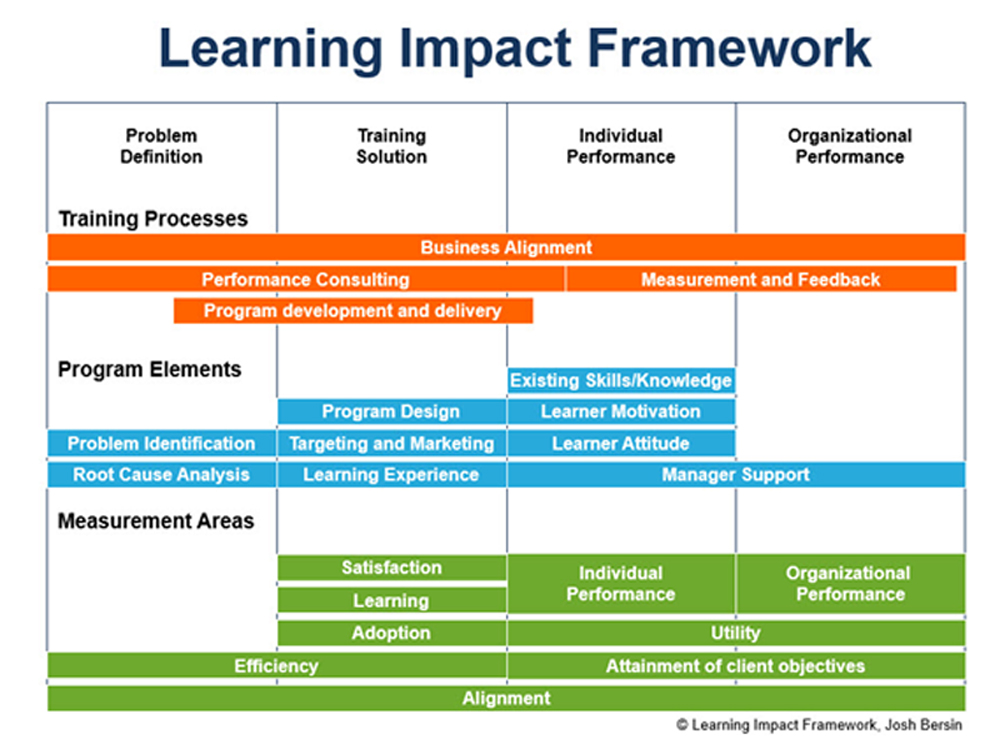
In the above diagram, we can clearly see the conventional learning strategy to measure learning impact.
Now you can find the current E-learning Architecture of today
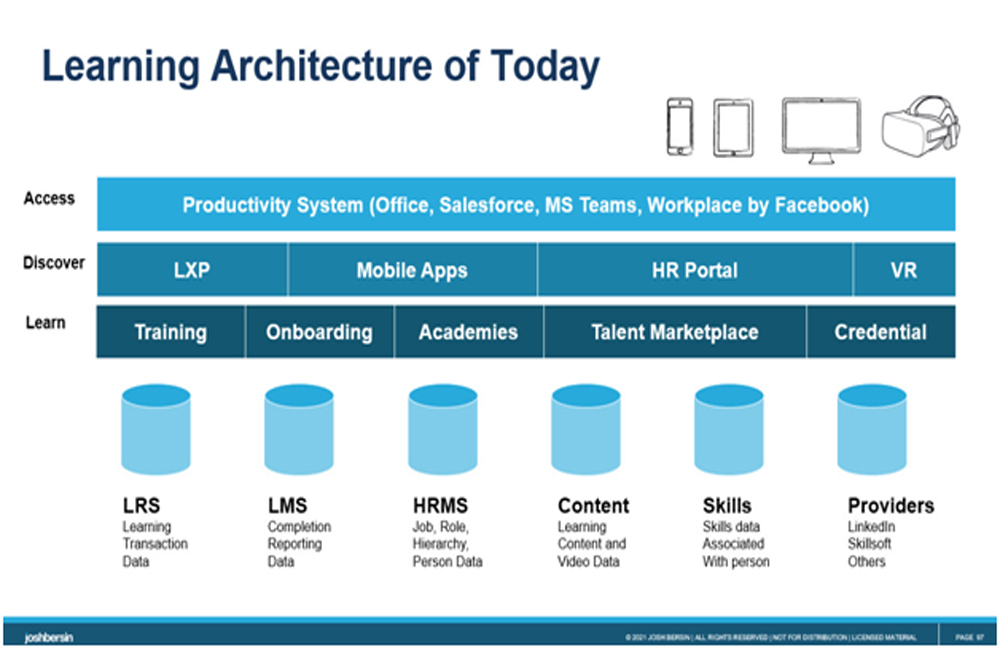
Hence, we note that the current e-learning architecture supports a wide range of learning solutions, which far exceeds the options which we had in the conventional learning system.
Learners have multiple options to learn through, mobile learning apps on the go.
In addition to that the entire capturing of data and monitoring progress is also just a click away.
2. 70:20:10 Learning framework
The 70-20-10 Model for Learning and Development is a commonly used formula within the training profession to describe the optimal sources of learning by successful managers. It holds that individuals obtain 70 percent of their knowledge from job-related experiences, 20 percent from interactions with others, and 10 percent from formal educational events.
The model was created in the 1980s by three researchers and authors working with the Center for Creative Leadership, a nonprofit educational institution in Greensboro, N.C. The three, Morgan McCall, Michael M. Lombardo and Robert A. Eichinger, were researching the key developmental experiences of successful managers.
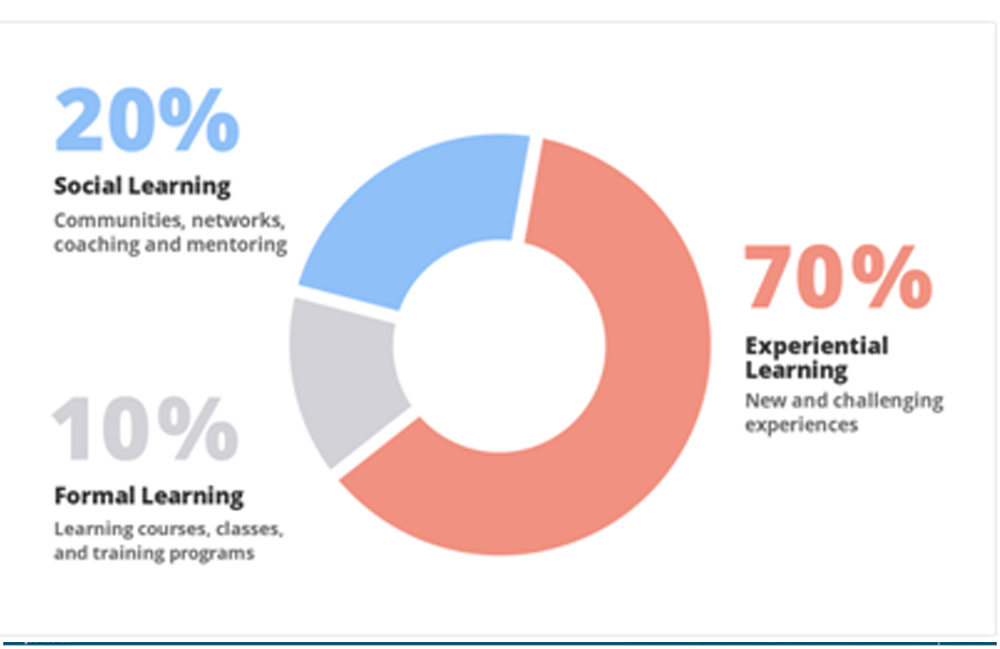
3. Shift toon-job training
Re-skilling and Up-skilling has become one of the most in demand learning formats according to the latest Sentiment Survey. Both Re-skilling and Up skilling have direct impact to the improvement of performance at job. In addition to this most of the jobs today is following a hybrid working model. Remote operations and work from home options have become inevitable. There are also many units which is have single operator units, where-in for the entire multifunctional branch, only one employee is deputed to work. Hence all the above-mentioned reasons give birth to the on-job training interventions as it can have a direct result while the learner to gets to try, experiment, practice until they reach perfection.
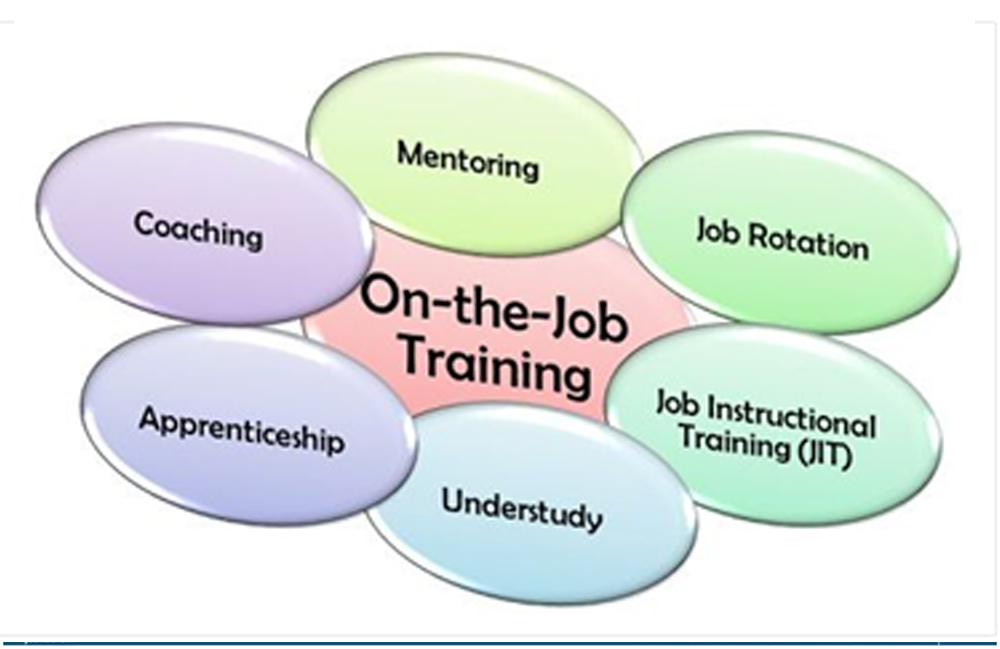
The workers can learn the skills that are required to be performed in the actual work conditions and also gets accustomed to the working environment. Also, the organizations need not to bear any additional cost of setting up a classroom or a simulated setup for imparting training to the workers, away from the actual work floor, as in the case of Off-the -Job training.
- Coaching: Under this method, the superior or an experienced staff gives instructions to the workers to perform a job. It is one-to-one training designed for the workers where they can find answers to their queries through the instructions and demonstrations given by the superior.
- Mentoring: This training is given to the managerial level people, wherein the senior or the manager gives instructions to the immediate subordinate to carry out the day-to-day functioning. It is again a one-to-one training method, where the manager is considered as a mentor to the subordinate and guides him in the situations of difficulty.
- Job Rotation: Under the job rotation, an employee is often shifted to the other related jobs, with the intention to make him well versed with other job backgrounds.
This helps him to escape the boredom caused by performing the same kind of work again and again and also helps in developing a rapport with other people in the organization.
- Job Instructional Training: Under this training, a trainer designs a step-by-step training program, wherein the worker is given the instructions to perform the job as required. Firstly, the overview of the job along with the desired results is explained to the trainee, and then the skills required for the job is demonstrated by the trainer.
Then a worker is allowed to perform the job as per his acquired skills or expertise, and then finally the workers are asked to give their feedback and ask for any query arising out of the training program.
- Understudy: Here, the superior gives training to the subordinate as an understudy or an assistant who is likely to perform a superior’s job in case of the vacancy arising out of superior’s retirement, transfer, promotion or death.
- Apprenticeship: This type of training is generally given to the people in crafts, trade and technical fields that require a long-term learning before they actually gain the proficiency in their respective disciplines.
This training is a blend of classroom and on-the-job training and is conducted under the close supervision. This can be extended up to 3 to 4 years as apprentices need to go through the learning process till they become an expert in their fields.
E.g., The craftsmen job, mechanic, electrician, plumber, tool maker, etc. have to undergo this type of training.
On-the-Job training is based on the principle of “learning by doing”, i.e., the workers learn the job while performing it within the actual work environment. This type of training is beneficial for both the workers and the organization.
4. Need for Learner Record store
The LRS is the “atomic database” of information that stores the detailed “clickstream” of learning. Just as advertising servers keep track on what ad you saw, what ad you clicked on, and even how long you hovered your mouse over an object, the LRS is designed to do the same for corporate learning.
These systems, which are sold by independent vendors like Learning Pool, LTG, and others, are part of your corporate learning architecture. Companies like Visa, Autodesk, HubSpot, AIT, Intuit, Yum! Brands, Walmart, NHS, Travelers, and others (all discussed in the research), have implemented these systems to get very detailed granular information about their learning.
In most companies, for example, it isn’t even clear what content is being used and what content is “wasted.” Companies spend millions of dollars on content libraries and then find out that much of the content is hardly used, while other documents or assets are red hot. The LRS helps you quickly figure this out – Josh Bersin
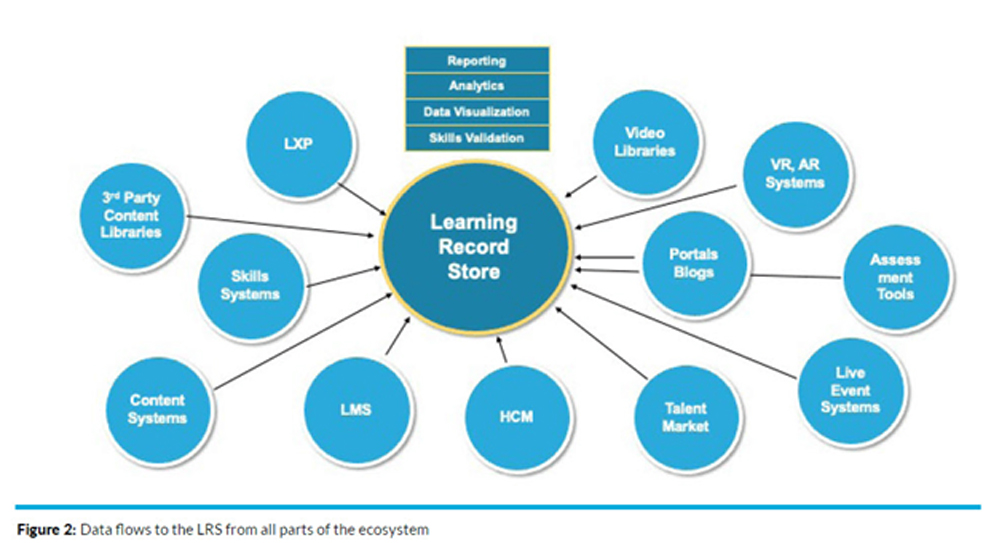
As the Learner Record store gains momentum, another key aspect to note is increasing demand for content curation. Learners today like to absorb content in formats that matches their interest. Gone are the days when a content was in a single format, like, document/video/scorm package/PPT/Audioetc…Now today’s learners want a single content broken down into multiple formats for them to consume. Hence the same course, may be broken down to multiple units and each unit will be having content in multiple formats to keep the learners engaged.
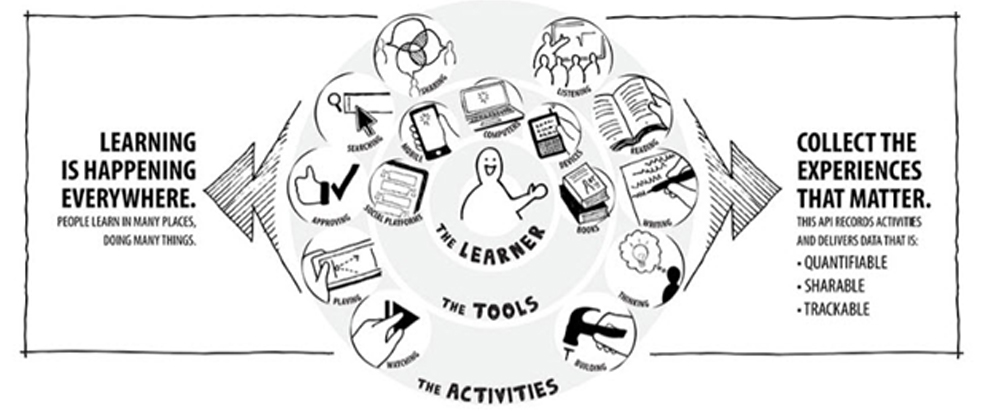
In addition to this evolution the learner is also having a wide range of tools and activities to learn. The focus of the learning platform is shifting towards Learner’s experience more than the technical features available in the platform. What is pivotal here is that all activities must be quantifiable, sharable and trackable.
5. Need for Creator platform for the learners
6. Collaborative learning platforms
“Collaborative learning platforms” is a broad term, so to provide you with the most helpful information, I need a bit more context. What are you hoping to learn about them? For example, are you:
- Looking for specific examples of popular collaborative learning platforms? (e.g., Edmodo, Padlet, Google Classroom)
- Interested in the features and benefits of collaborative learning platforms? (e.g., group projects, discussion forums, knowledge sharing)
- Curious about how collaborative learning platforms can be used in different educational settings? (e.g., K-12 classrooms, university courses, corporate training)
- Seeking advice on choosing the right collaborative learning platform for your needs?
Once I understand your specific needs, I can provide you with a more focused and relevant response.
Additionally, if you have any specific keywords or questions in mind, feel free to share them as well. The more information you give me, the better I can help!
7. Focus shifted to the Learner’s experience
The shift in focus towards the learner’s experience is a significant trend in various fields, especially education and training. It signifies a move away from traditional, teacher-centered approaches to ones that prioritize the individual needs and preferences of learners. This shift has brought about several positive changes, including:
Increased engagement and motivation: When learners feel their needs and interests are being considered, they become more engaged in the learning process. This leads to better knowledge retention, improved skills development, and a more positive overall learning experience.
Personalization and customization: With a learner-centered approach, instruction and resources can be adapted to individual learning styles, paces, and goals. This ensures that everyone gets the support and challenge they need to succeed.
Active learning and collaboration: Learner-centered environments encourage active participation, collaboration, and critical thinking. This not only makes learning more enjoyable but also equips learners with essential skills for the real world.
Empowerment and ownership: When learners feel in control of their own learning journey, they become more empowered and self-directed. This fosters a sense of responsibility and ownership over their learning, leading to greater long-term success.
Technology as a facilitator: The growing availability of technology plays a crucial role in supporting a learner-centered approach. Tools like learning management systems, adaptive learning platforms, and collaborative tools can personalize learning experiences, provide immediate feedback, and enable learners to connect with each other.
Beyond formal education: The learner-centered approach is not limited to traditional educational settings. It is also gaining traction in corporate training, professional development, and even personal development.
However, shifting to a learner-centered approach requires acknowledging some challenges:
Increased workload and planning: Designing and implementing personalized learning experiences for individual learners can be demanding for educators and trainers.
Assessment and evaluation: Traditional methods of assessment might not be suitable for evaluating learning in a dynamic, individualized environment.
Accessibility and equity: Ensuring that all learners have equal access to resources and opportunities can be challenging, especially in resource-constrained settings.
Despite these challenges, the benefits of a learner-centered approach far outweigh the difficulties. By embracing this shift, we can create more effective, engaging, and empowering learning experiences for everyone.
Do you have any specific questions about the learner-centered approach or its implications for a particular field? I’m happy to provide further insights!
8. Agile Monitoring of Learners: A Dynamic Approach to Learner Success
The learner-centered focus necessitates agile monitoring methods that move beyond traditional, rigid assessments. Here are some key characteristics of agile monitoring:
Continuous feedback and assessment: Gone are the days of infrequent tests and yearly evaluations. Agile monitoring emphasizes ongoing feedback through various channels, like:
- Micro-assessments: Quick quizzes, performance checks, or self-evaluations embedded within learning activities provide immediate insights into progress and challenges.
- Peer feedback: Collaborative projects and activities can incorporate peer review mechanisms, fostering valuable learning from each other.
- Observational assessments: Educators and trainers can closely observe learners’ engagement, participation, and problem-solving skills during activities.
- Data-driven insights: Learning management systems and other technological tools can track learner progress, engagement metrics, and resource utilization, offering data-backed insights for personalized interventions.
Focus on learning progress and goals: Agile monitoring aims to understand not just performance on specific outcomes, but also the learner’s progress towards their individual goals and desired learning outcomes. This involves:
- Regular goal-setting: Learners actively participate in setting their learning goals, ensuring engagement and ownership of the learning journey.
- Progress tracking: Visual dashboards and personalized reports keep learners informed of their progress against goals, empowering them to adapt their learning strategies as needed.
- Adaptive interventions: Based on ongoing assessments and feedback, educators can provide targeted support and resources to address specific learner needs and accelerate progress.
Flexibility and responsiveness: Agile monitoring adapts to the dynamic nature of learning. This means:
- Regular iterations: Monitoring processes are flexible and adjusted based on the learner’s progress and changing needs.
- Open communication: Frequent feedback loops and open communication channels between learners, educators, and peers allow for timely adjustments and support.
- Embrace of experimentation: Trying out new learning activities, technologies, and assessment methods encourages continuous improvement and responsiveness to individual learner needs.
Tools and technologies: While a learner-centered approach prioritizes human connection and interaction, technology can significantly enhance agile monitoring:
- Learning management systems: LMS platforms can track progress, deliver feedback, and facilitate communication.
- Adaptive learning platforms: These platforms personalize learning pathways based on individual learner data.
- Collaboration tools: Platforms like online discussion forums and project management tools enable peer interaction and feedback.
- Performance tracking tools: Real-time data dashboards and analytics provide insights into learner engagement and skill development.
Benefits of agile monitoring:
- Increased learner engagement and motivation: Real-time feedback and personalized support keep learners invested in their learning journey.
- Improved learning outcomes: Adaptive interventions and focused support optimize learning pathways and accelerate skill development.
- Empowered learners: Continuous feedback and goal-setting fosters ownership and self-directed learning.
- Data-driven insights for educators: Monitoring data informs instructional decisions and improves the overall learning experience.
Remember, agile monitoring is not a one-size-fits-all solution. The key is to be flexible, responsive, and adapt the approach to fit the specific needs and learning goals of each individual learner.
Do you have any specific questions about implementing agile monitoring in your learning context? I’d be happy to offer further advice and discuss how to adapt this approach to your needs.
9. Creative and insightful reports and analytics
When it comes to creative and insightful reports and analytics, the goal is to move beyond dry data tables and static charts to tell compelling stories that drive action. Here are some ways to achieve this:
Focus on insights, not just data: While data is the foundation, the power lies in extracting meaningful insights and translating them into actionable recommendations. Don’t simply report the numbers; explain what they mean and why they matter.
Embrace visual storytelling: Ditch the boring bar charts and pie graphs. Utilize creative data visualization techniques like infographics, interactive dashboards, and even data art to capture attention and make complex information easily digestible.
Dive deeper with data mining and analysis: Go beyond descriptive statistics and leverage advanced techniques like data mining, anomaly detection, and predictive modeling to uncover hidden patterns and trends that traditional methods might miss.
Personalize your reports: Tailor your reports to the specific needs and interests of your audience. Use their language, focus on relevant metrics, and highlight information that will resonate with them.
Incorporate storytelling elements: Use narrative structures, anecdotes, and case studies to bring your data to life and make your reports more engaging. Imagine yourself as a data detective, building a compelling case with evidence and logical reasoning.
Focus on the “so what?” Don’t just present data; connect it to real-world implications and actionable insights. Show how the insights can be used to make better decisions, optimize processes, or achieve specific goals.
Emphasize trends and comparisons: Track data over time and compare it to benchmarks or competitor performance to identify trends, analyze performance gaps, and predict future outcomes.
Consider interactive elements: Make your reports interactive by embedding clickable elements, drill-down features, and filters that allow users to explore the data in their own way and glean their own insights.
Don’t forget the human touch: While data is important, remember that reports are ultimately used by human beings. Add a personal touch by including your own expertise and insights to guide the reader’s understanding and interpretation of the data.
Embrace humor and creativity: Don’t be afraid to inject a little humor or creativity into your reports. A well-placed quip or a clever visual metaphor can make your reports more memorable and impactful.
By following these tips, you can transform your reports and analytics from dusty documents to insightful stories that spark curiosity, inspire action, and drive real results. Remember, the key is to be creative, insightful, and always ask yourself: “What story is my data trying to tell?”
10. Micro-learning in regular intervals
The beauty of micro-learning lies in its ability to deliver knowledge in short, digestible bursts – perfect for our fast-paced, information-dense world. Integrating these bite-sized nuggets into regular intervals throughout the day can unlock a multitude of benefits for learners:
Enhanced engagement and retention: Short, focused bursts of information combat attention fatigue, keeping learners engaged and actively processing new material. This leads to better knowledge retention compared to longer, traditional learning sessions.
Improved accessibility and time management: Micro-learning’s flexibility allows learners to fit learning into their existing schedules, regardless of time constraints. Short modules can be accessed on the go, during breaks, or even while commuting, making knowledge acquisition seamless and convenient.
Personalized learning journeys: Regular micro-learning intervals provide opportunities for personalized learning pathways. Learners can choose the topics and frequency that best suit their needs and pace, fostering a sense of ownership and control over their learning journey.
Reinforcement and spaced repetition: Regularly scheduled micro-learning sessions facilitate spaced repetition, a proven technique for memory consolidation. Revisiting key concepts at predetermined intervals strengthens neural connections, resulting in long-term information retention.
Application and skill development: Short bursts of learning can be combined with practical activities and applications to solidify understanding and refine skills. Regular intervals provide ample opportunities to put newly acquired knowledge into practice, ensuring its relevance and impact.
Motivation and confidence: Consistent progress through micro-learning fosters a sense of accomplishment and builds confidence in learners. Witnessing their knowledge grow incrementally keeps them motivated to continue learning and tackle new challenges.
Here are some effective ways to integrate micro-learning in regular intervals:
- Leverage mobile learning platforms: Utilize mobile apps or platforms specifically designed for short, on-the-go learning modules.
- Schedule micro-learning breaks: Dedicating specific times throughout the day, like morning routines or lunch breaks, can create a routine for regular knowledge consumption.
- Utilize push notifications and reminders: Set up automated notifications to prompt learners for quick learning bursts at desired intervals.
- Gamify the learning process: Incorporate points, badges, or leaderboards to add a competitive element and encourage consistent engagement with micro-learning modules.
- Align micro-learning with real-world applications: Connect short sessions to practical tasks or challenges, showcasing the immediate value of the acquired knowledge.
Remember, the key to success lies in finding the right frequency and format for your learners. Experiment with different schedules, platforms, and content types to discover the sweet spot that keeps them engaged, motivated, and empowered to learn continuously.
By harnessing the power of micro-learning in regular intervals, you can break down knowledge into manageable chunks, overcome time constraints, and unlock a world of continuous learning and growth for your learners.
Feel free to ask if you have any specific questions or would like to explore different implementation strategies for your unique context!
discover hidden gems that Green LMS helps you leverage to ignite learning, boost engagement, and transform your entire training ecosystem. Green LMS can be tailored for various applications, including higher education LMS, Schools LMS, LMS for corporate training, and LMS for business development and Click here for a Free LMS Demo Now.


